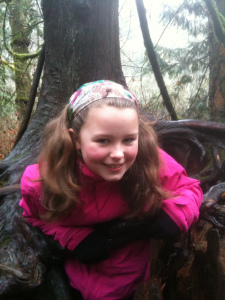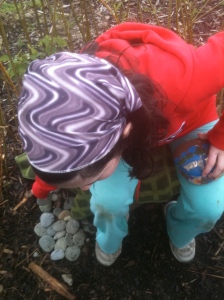Natural Escape Routes for Children
November 29, 2013
An empathy with the natural world can become a vital part of children’s psyches; they will learn to take nothing for granted, and will continually probe and ponder. They will have a sense of wonder and mystery about the world around them; it will become a vibrant part of their consciousness…In short, they will feel committed and responsible for the world in which they have been placed as caretakers for a brief moment of time (Paddy Madden, Go Wild at School).
The following is a summary of some of these research findings.
1. Nature enhances children’s skills in the following areas –
Problem Solving, Teamwork, Experimentation, Decision-Making, Adaptability, Confidence, Enhanced Communication, Sensory Development, Intellectual Stimulation (Carol Duffy, Childhood Specialist, Ireland)
2. Recent research proposes that exposure to the outdoors reduces anxiety, and enhances learning. (Dr. Dorothy Matthews, American Society for Microbiology)
3. “A den (made from natural materials) is the child’s sense of self being born, a chance to create a home away from home that becomes a manifestation of who they are. The den is the chrysalis out of which the butterfly is born.” (David Sobel, Antioch New England Graduate School)
4. “By bolstering children’s attention resources, green spaces may enable children to think more clearly and cope more effectively with life stress”. Engagement with natural settings has been linked to a child’s ability to focus, and enhances cognitive abilities. Nearby nature is a buffer for anxiety and adversity in children. (Dr Nancy Wells, Cornell University, New York)
5. The outdoor environment enhances the understanding of social relationships, language, physical movement, reasoning, curiosity, and the capacity to imagine possibilities. (Jane Williams-Siegfredsen, Viborg University College, Denmark)
6. Fostering children’s identity to include personal and social relationships with nature, improves their empathy and sense of inter-connection with the world-at-large. (Anita Barrows, Clinical Psychologist, Berkeley, California)
7. Nature can activate sensory, emotional, cognitive, symbolic and creative levels of human experience through de-familiarisation. Taken for granted everyday things, are sensitively given new meaning and enhance a child’s capacity to perceive. (Jan Van Boeckel, Research Fellow Aalto University Helsinki, Anthropologist, Filmmaker)
8. “Involuntary attention, as opposed to directed attention, can be cultivated within nature”. The “soft fascination” of the natural world can restore focussed attention required for directed studies. Involuntary attention is achieved without effort by simply observing what captures our attention. Our mind wanders and takes a rest from concentrated effort, which in turn improves learning. (Marc Berman, Brain Scientist, University of Michigan)
References
Paddy Madden, Go Wild at School
Children and Nature Network childrenandnature.org
Nature Art Education http://www.naturearteducation.org
Natural Relations: Arts and Health
September 6, 2012
 A summer long residency at Ferdia House Ardee (part of Moorehall Healthcare for older people), worked to develop an arts studio adjacent to the dining area of Moorehall Retirement Village. The project incorporated botanical drawing, fibre arts, poetry, photography, print making, crocheted shapes and sewn images. Herbal tonics were prepared and shared at the end of each session, linking the art project to herbs growing in gardens located outside of Ferdia House.
A summer long residency at Ferdia House Ardee (part of Moorehall Healthcare for older people), worked to develop an arts studio adjacent to the dining area of Moorehall Retirement Village. The project incorporated botanical drawing, fibre arts, poetry, photography, print making, crocheted shapes and sewn images. Herbal tonics were prepared and shared at the end of each session, linking the art project to herbs growing in gardens located outside of Ferdia House.
The display of artworks grew progressively throughout the sessions, and are now displayed within windows and suspended as floating botanical forms. Magnified seeds, root shapes and plant cells were the prevailing forms of artistic inquiry for the project.
Participants said they were impressed with the many ways they worked with different kinds of art materials. They particularly enjoyed using a small microscope for observing plant cells. Ferdia House Manager, Breege Conlon said “It’s art at many levels, a holistic approach where people can participate at whatever level they can. The idea of the studio is important, as people can come and go when they want to, and explore different kinds of materials and ways of looking at art.”


Seeds: A Studio for Arts and Health
August 27, 2012

Over the course of the summer an arts residency at Moorehall Healthcare (Ardee, County Louth) has developed an art studio devoted to exploring the interiors of plants (through microscopic images) and the magnified shapes of wildflower seeds and various root systems. Residents from Moorehall Retirement Village and Moorehall Lodge have explored these shapes through drawing, creative writing, photography, crochet, printing, sewing and paper mache. The title of the project was inspired by a book written by Rob Kesseler and Wolfgang Stuppy of The Royal Botanic Gardens, Kew entitled Seeds: Time Capsules of Life. Seeds combine the past, present and future; they are inter-generational and sophisticated. Each seed is a vessel, a life force waiting for the right conditions within which to flourish. These themes can be applied to the creation of an arts and health studio, whereby participants can produce artworks which grow as a collective ecology of connections which influence each other.
The studio offered participants an opportunity to work with a variety of art materials, and to display their work as a collection of different ideas and perspectives. The botanical nature of the studio was intended to interact with the planting of three new garden areas located within Moorehall Retirement Village. These three gardens composed of  wildflowers, herbs, cottage garden flowers, soft fruits and vegetables were created in conjunction with 4th Class students at Scoil Mhuire na Trocaire to mark the European Year of Active Ageing and Intergenerational Solidarity (2012).
wildflowers, herbs, cottage garden flowers, soft fruits and vegetables were created in conjunction with 4th Class students at Scoil Mhuire na Trocaire to mark the European Year of Active Ageing and Intergenerational Solidarity (2012).
Within the studio participants shared poetry, music, a selection of herbal tonics and discussed the artworks of artists who work with ecological themes, such as Katie Holten, Herman de Vries, Richard Long and Chris Drury.



